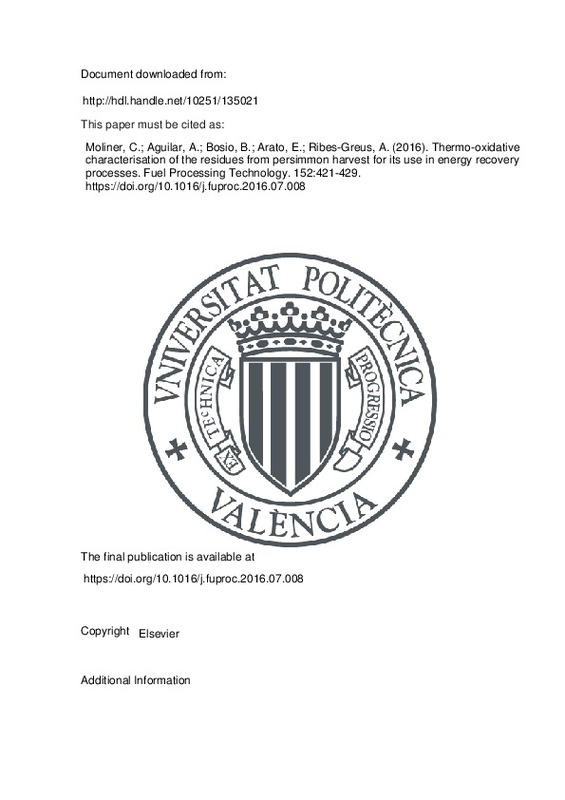JavaScript is disabled for your browser. Some features of this site may not work without it.
Buscar en RiuNet
Listar
Mi cuenta
Estadísticas
Ayuda RiuNet
Admin. UPV
Thermo-oxidative characterisation of the residues from persimmon harvest for its use in energy recovery processes
Mostrar el registro sencillo del ítem
Ficheros en el ítem
| dc.contributor.author | Moliner, C.
|
es_ES |
| dc.contributor.author | Aguilar, A.
|
es_ES |
| dc.contributor.author | Bosio, B.
|
es_ES |
| dc.contributor.author | Arato, E.
|
es_ES |
| dc.contributor.author | Ribes-Greus, A.
|
es_ES |
| dc.date.accessioned | 2020-01-18T21:01:24Z | |
| dc.date.available | 2020-01-18T21:01:24Z | |
| dc.date.issued | 2016 | es_ES |
| dc.identifier.issn | 0378-3820 | es_ES |
| dc.identifier.uri | http://hdl.handle.net/10251/135021 | |
| dc.description.abstract | [EN] The residues from the harvest of persimmon fruit will be thermally valorised by means of high temperature reactions within a spouted bed reactor. With the aim to obtain valuable information for the design of the device, the thermo-chemical processes were simulated by multi-rate linear non-isothermal Thermogravimetric Analysis (TGA) using O-2 as carrier gas. In addition, a set of analyses were carried out using Ar as carrier gas in order to evaluate the influence of the atmosphere (oxidative or inert conditions) on the decomposition of the samples evaluating the reactions of pyrolysis. The release of gases was monitored by Evolved Gas Analysis (EGA) with in-line Fourier Transformed Infrared (FT-IR) analysis. The thermochemical reaction was mathematically described through the definition of the main kinetic parameters: activation energy (Ea), pre-exponential factor (In A) and model and order of reaction (n). The so-called kinetic triplet was calculated through the application of a methodology based on complementary isoconversional methods. These results will be the initial parameters that will help design the Spouted Bed Reactor and it is envisaged that they will be used in computer simulation software to achieve a better understanding of the process to obtain the optimum operational parameters. (C) 2016 Published by Elsevier B.V. | es_ES |
| dc.language | Inglés | es_ES |
| dc.publisher | Elsevier | es_ES |
| dc.relation.ispartof | Fuel Processing Technology | es_ES |
| dc.rights | Reserva de todos los derechos | es_ES |
| dc.subject | Persimmon fruit | es_ES |
| dc.subject | Energy valorisation | es_ES |
| dc.subject | Thermo-oxidative decomposition kinetics | es_ES |
| dc.subject | Evolved-gas analysis | es_ES |
| dc.subject.classification | MAQUINAS Y MOTORES TERMICOS | es_ES |
| dc.title | Thermo-oxidative characterisation of the residues from persimmon harvest for its use in energy recovery processes | es_ES |
| dc.type | Artículo | es_ES |
| dc.identifier.doi | 10.1016/j.fuproc.2016.07.008 | es_ES |
| dc.rights.accessRights | Abierto | es_ES |
| dc.contributor.affiliation | Universitat Politècnica de València. Departamento de Máquinas y Motores Térmicos - Departament de Màquines i Motors Tèrmics | es_ES |
| dc.contributor.affiliation | Universitat Politècnica de València. Instituto de Tecnología de Materiales - Institut de Tecnologia de Materials | es_ES |
| dc.description.bibliographicCitation | Moliner, C.; Aguilar, A.; Bosio, B.; Arato, E.; Ribes-Greus, A. (2016). Thermo-oxidative characterisation of the residues from persimmon harvest for its use in energy recovery processes. Fuel Processing Technology. 152:421-429. https://doi.org/10.1016/j.fuproc.2016.07.008 | es_ES |
| dc.description.accrualMethod | S | es_ES |
| dc.relation.publisherversion | https://doi.org/10.1016/j.fuproc.2016.07.008 | es_ES |
| dc.description.upvformatpinicio | 421 | es_ES |
| dc.description.upvformatpfin | 429 | es_ES |
| dc.type.version | info:eu-repo/semantics/publishedVersion | es_ES |
| dc.description.volume | 152 | es_ES |
| dc.relation.pasarela | S\334091 | es_ES |







![[Cerrado]](/themes/UPV/images/candado.png)

